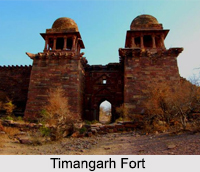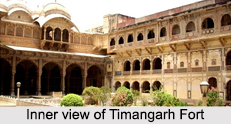 Timangarh Fort is positioned on a strategic location of 40 kilometers from Princely State of Karauli in Rajasthan. This fort is a hub of a number of ancient idols and scriptures. There are thousands of Astadhatu and stone statues of the Hindu Gods and Goddesses inside the fortress. The name "Timangarh" is assumed to be in recognition of Raja Timanpal`s contribution.
Timangarh Fort is positioned on a strategic location of 40 kilometers from Princely State of Karauli in Rajasthan. This fort is a hub of a number of ancient idols and scriptures. There are thousands of Astadhatu and stone statues of the Hindu Gods and Goddesses inside the fortress. The name "Timangarh" is assumed to be in recognition of Raja Timanpal`s contribution.
History of Timangarh Fort
The Timangarh Fort is said to have been built around 1100 AD, with some destruction thereafter. Its reconstruction is said to have been undertaken in 1058 AD by Raja Timanpal of YaduVanshi, the scion of Vijay Pal, the Raja of Bayana. The villagers believe that its residents deserted the Timangarh Fort almost 300 years back.
There is a local believe that the fort is supposed to carry the curse of a Natini (a trapeze artiste), and there is a "Natini ka Khamba" or Natini`s Pillar located in the neighbouring plains area, about 3 km from the Fort. It is said that the King challenged the Natini to walk over a rope stretching almost 2 km near the entrance. He promised her half of his kingdom in return. She completed the course from one side to the other, but on her return journey, the Ranis panicked about the deal and ordered the rope to be cut being unable to find a way otherwise. The Natini fell and died, but placed a curse on the king that his majestic fort would one day be in ruins.
Architecture of Timangarh Fort
The beautiful carvings on the temples of the Timangarh Fort have both religious and geometrical fervor. This fort has a striking proof of the exquisite workmanship of highly skilled artisans that once operated in this region.
The Timangarh Fort is originally believed to have had five entrances but some more gates were apparently added later by the rulers of Mughal Dynasty. The later gates were the additions. They are apparent from the way where some carved blocks from deep inside the fort have been used in the construction of the gate at the main entrance to the Fort, along with plain-faced stone blocks of different colours and variety. The Fort is thus believed to have been under occupation of Mohammad Ghori`s forces from 1196 to 1244 AD after the Second Battle of Tarain.
The entrances at the Fort bear the markings of Mughal construction. One can see some carved stone slabs with writings on them at the main entrance, in stark contrast to the simple plain faced stone slabs used elsewhere in its construction.
 The interiors of the fort were not touched by the Mughals. One can still see the remains of an ancient township, complete with palaces, temples, bazaars, and houses in the area. Some of the most exquisite ancient carvings are geometrical, flower- patterned and religious. They adorn their rooftops and pillars.
The interiors of the fort were not touched by the Mughals. One can still see the remains of an ancient township, complete with palaces, temples, bazaars, and houses in the area. Some of the most exquisite ancient carvings are geometrical, flower- patterned and religious. They adorn their rooftops and pillars.
The Gods, Goddesses and their villainous and tantric counterparts adorn these pillars, though most of them have now been broken up and plundered by the smuggler gangs operating in the region. Idols are of stone sculpture and ashtadhatu statues studded with gems. The idols are from all religious groups- Jains, Buddhist and Hindu. It has been heard that the astadhatu idols of Lord Ganesha and Lord Vishnu were the favourite subjects of the sculptors.
Almost seven hundred years back, the pillars of some of the temples and houses were apparently lined with simple bricks and converted into bunker like closed structures. Inside these buildings there were a number of expensive ashtadhatu idols brought from various parts of Uttar Pradesh, Delhi, Madhya Pradesh and other parts of North India, to save the idols from plunderers.
Timangarh Fort also offers a beautiful view of the Sagar lake, and the local villagers still cherish the hopes of that day, when they can find the "Paras" stone believed to be somewhere at the bottom of the lake.



















